The ocean -the open stuff -is alive, bounding, rebounding, crashing, rolling, breaking, sucking back, roaring, hissing, thundering, and ominously quiet.
~ Sea diary, June 2010, Dixon Entrance, Alaska
It’s been said that a person doesn’t take a trip, but rather a trip takes a person. The Inside Passage took me – in a kayak – from Anacortes, Washington, to Juneau, Alaska. It took me through glacially carved landscapes and impenetrable forests, narrow channels and wide ocean passages, barreling fronts and mixmaster waves. It was a journey of the sea and the soul that took me both north to Alaska and inward, as I discovered the depths of my own strength and courage. I have still only begun to understand its impact.

The Inside Passage is a narrow artery that connects with, and is a part of, the 64 million square miles that comprise the Pacific Ocean. The most scenic and challenging paddling trip in North America, it’s touted as a holy grail for those accessing it in long, skinny boats. This alone was enough to lure me into planning an expedition up its labyrinthine coast.
Seattle is considered the official starting point and Skagway the terminus where one literally runs out of ocean, about 1,300 miles later. After traversing through a snippet of northwest Washington, including an oblique trajectory through the San Juan Islands, the route extends north along British Columbia’s coastline. Dixon Entrance plays sentinel to the Alaskan boundary and from there the “IP” snakes its way up Alaska’s panhandle, where Skagway waits at the pinnacle like a grand finale.
Departure
My journey began in spring 2010, from a crescent-shaped public beach at Washington Park, just outside Anacortes, Washington. A poignant departure arranged by a small group of friends included a champagne-christened bow, a round of goodbye hugs, and a gentle shove to my stern that had me paddling away from the safety and protection of Fidalgo Island. Ten strokes later, as I rounded a small public dock, two old salts rigging their fishing boat asked where I was headed.
“Alaska,” I replied matter-of-factly, with a deliberate pause between my strokes. I could hear my friends chuckle on the beach behind me, and my big, toothy grin could have lit up the ocean. Sixty-six days, 1,148 miles, 102 dark chocolate bars, 28 ibuprofen gel caps, seven temper tantrums, five anxiety attacks, two pairs of underwear, one foul wetsuit, and a million magical moments later, I laid my paddle down in Juneau, Alaska.

During that time I lived indefinitely in a wetsuit, paddled marathon distances for weeks on end, forged friendships with quirky people in the strangest of places, and pretended not to be intimidated by 700-pound grizzly bears and 40-ton whales. I lived my dream.
That dream entailed paddling through wild, steep country, subject to strong currents and wind. The realities of hypothermia, dwindling food supplies, non-existent beaches, and extreme tidal differences – alarmingly rising walls of water measuring over twenty feet -were part and parcel of the journey. At times I floated in a magical world among whales and icebergs and immeasurable beauty; other times I paddled wildly with fear at my back.
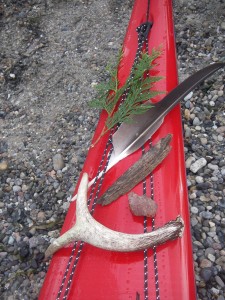
My experience paddling through the Alaska panhandle was perhaps the wildest and most magical of all. On my 45th day at sea, with 700 miles trailing behind my stern and approximately 500 imminent on my bow, I bobbed on the imaginary border that represented the separation of Alaska from British Columbia. Estimating from my chart and nearby landmarks, I had reached a major milestone – I had arrived at the Alaskan border via sea kayak! I paddled up a narrow channel speckled with several inviting beaches. Brilliant red Indian paintbrush flourished in pockets of sparkly white sand. Shards of mica-speckled obsidian rocks and veins of quartz punctuated the rocky seashore.
The next day my kayak slid over the robust swells of Dixon Entrance, and my surroundings, I thought, began to take on a different look and feel. I skidded around the next point, and there it was: an alive, wide-awake ocean. The landscape seemed more open. The mountains loomed bigger. Rocks seemed shinier. The water, more blue. I noticed more hemlocks and various species of deciduous trees in this land of the midnight sun. It all beckoned me, as if I were paddling into another dimension.
Ice and Whales
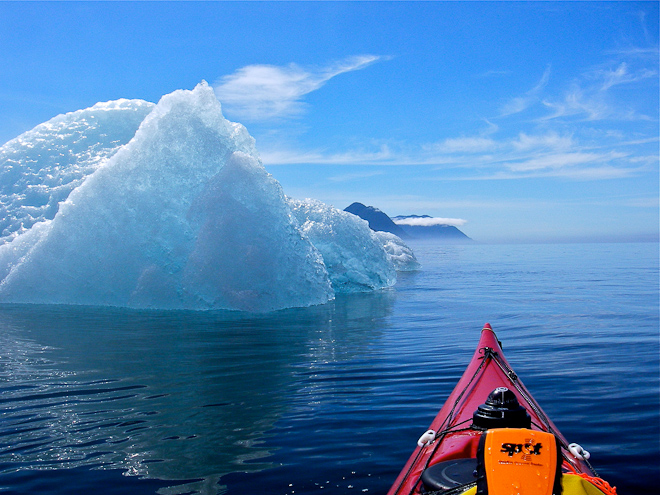
Several weeks later, nearing Juneau, and the end of my adventure, the ethereal blue ice of Sumdum Glacier hung over my camp, frozen in time, etched in jaw-dropping beauty. It was the most pristine and seductive campsite of the trip so far, in spite of the amusing name. I knew from my pre-trip research that Mount Sumdum, Sumdum Bay, and Sumdum Island shared the same whimsy. John Muir wrote extensively about this area in Travels in Alaska, and not once did he indicate a tongue-in-cheek attitude when he wrote about the Sumdum ice, the Sumdum seal hunters, or the Sumdum Indians. I, on the other hand, couldn’t stop smirking. The Dictionary of Alaskan Place Names reports that the Tlingit Indians who lived nearby named it Sumdum to embody the booming sound of icebergs as they broke off the glacier. Another account states that from 1897 to 1942 the area was the site of an active mining camp, named Sumdum, complete with a tram, brewery, and post office.
Holkham Bay (as Sumdum Bay is now named), where Sumdum Glacier meets the sea, showed no signs of past activity. Camped deep inside the bay I watched icebergs flaunt their allure in front of me, suspended timelessly in the peaceful cove. Some resembled ice sculptures: swans, Volkswagens, crocodiles. Loons, the symbol of wilderness and solitude, floated amongst them on the glassy smooth water. Around the corner of a small rock outcropping, out of my line of sight, something snorted loudly in the water. A sea lion, perhaps?

Paddling north the next day, I encountered several humpback whales competing for attention, giant cetaceans swimming circles around me. One slapped the water with its white pectoral fin, then dove deep, its tail fluke spanning nearly fifteen feet, momentarily suspended between sky and sea. Three other humpbacks intermittently stayed on the surface and sang melodious and mysterious songs to each other, repeating patterns of chirrups, sighs, moans, and growls. I listened to this hauntingly beautiful outdoor symphony, watching long, curving backs oscillate through the water for a few more magical moments before they silently slipped beneath the surface.
Two bays north, I floated in tranquil solitude – until a super-pod of orcas burst into my reality in full-on frolic mode. Thirty-foot-long black and white polished bodies cannonballed on the water’s surface. Thunderous claps filled the air, emulating gunfire, as the whales breached and spiraled, then smacked the water with massive force. Their communicative nature resonated across the water as dorsal fins, tail flukes, and a cacophony of sounds surrounded me. My gaze swept in an arc across the bay; I was afraid I would miss any number of sideshows. The big daddies, showing off their triangular, six-foot-high dorsal fins, paraded in front of me. Swimming powerfully and gracefully, they undulated and then dove, cutting through the water in a trajectory that had one red kayak in its epicenter. I gasped as one swam beneath me. Looking down in a combination of amazement and fright, it appeared as if a submarine might surface directly below me.

I continued to glide through paradise on this radiant, eye-piercing afternoon. I would pitch my tent one last time that night on a small pebble crescent beach nestled into a slim indentation just north of Slocum Inlet. Its amenities included profuse amounts of dazzling pink fireweed, a babbling brook, and sweeping views of Stephens Passage. Gastineau Channel, my final approach to Juneau, loomed in the distance. Icebergs floated by; whales serenaded me. As the night opened before me and the pulse of the day slowed, as nature fell into order and my journey drew to its end, I reflected on the many mind-blowing, altogether intoxicating moments of this adventure, along with the challenges that were, at times, more than I had bargained for. I then realized that this opportunity was not only a passage to adventure, but a journey deep inside myself, a journey that revealed many lessons, and answered questions that I hadn’t yet thought to ask.
Home
About a week later I was packed up and ready to disembark Alaska Ferry’s MV Columbia, my south-bound shuttle that would rewind my epic journey in three whirlwind days. I stood on the ship’s tallest deck and watched the now-familiar brick building of the Bellingham ferry terminal come into view. Within minutes I could pick my friend Becky out of the crowd, her arms waving high and wildly back and forth to greet me. My heartbeat quickened as my feet approached terra firma—and the end of this adventure.

I relaxed in Becky’s pickup truck while she negotiated the tapered twists and turns of Chuckanut Drive, and I enjoyed sweeping views of the San Juan Islands and Samish Bay. Further south the road widened and flattened as it ran through the fertile farmlands of the Skagit River Valley. Soon, we headed west for Anacortes, back to the same beach where I began my trip, seventy-three days earlier.
Standing in the very spot where I launched, I tuned into the memories and emotions of that inaugural day. Feeling gratitude for being safely delivered back to these shores, I put my hands in prayer position at my heart and flowed into three sun salutations, thanking the water gods for where I’d been, for where I was now, and for where I was going. The circle was complete.
View an extended photo gallery of Susan’s beautiful images captured on her trip here.
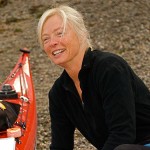 Susan Conrad is a writer and photographer whose tenacious exploration by sea kayak has fueled her stories and images of the natural world for decades. An introvert trapped in an extrovert personality, she organizes and hosts Blazing Paddles—A Paddling Film Festival to keep her speaking and social skills intact. She is currently deep in the throes of completing her debut memoir Inside about her 1,200-mile solo sea kayak expedition to Alaska.
Susan Conrad is a writer and photographer whose tenacious exploration by sea kayak has fueled her stories and images of the natural world for decades. An introvert trapped in an extrovert personality, she organizes and hosts Blazing Paddles—A Paddling Film Festival to keep her speaking and social skills intact. She is currently deep in the throes of completing her debut memoir Inside about her 1,200-mile solo sea kayak expedition to Alaska.
Stay tuned for Susan’s book “Inside: A Woman’s Solo Journey Through the Inside Passage.” Her debut memoir will detail her entire epic journey on the Inside Passage. Check out her website here. at http://www.susanmarieconrad.com/
 AdventuresNW
AdventuresNW


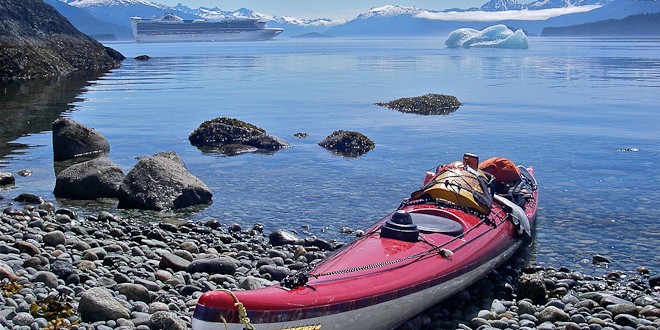
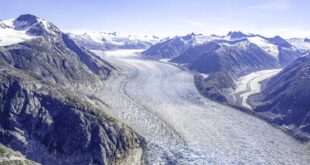
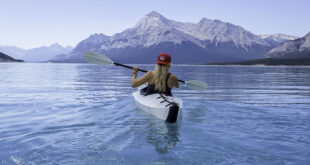

Hi Susan,
I absolutely love what you did! I finished riding around on my motorbike for three years through the US, Canada and Alaska. I did not meet a single solo woman riding around like me, which was a bummer!
I am currently planning a similar trip, but by kayak with Valdez AK as end destination.
I would like to ask how you went about restocking your food supply without fear of getting your kayak and possessions ripped off. I also wanted to know how to deal with customs upon entering Canada by water.
Hi Esther,
Thanks for reaching out. It sounds like you’ve got a great adventure planned to Valdez!
I had 6 resupply ports of call: Powell River, Port Hardy, Shearwater, Prince Rupert, Ketchikan, and Petersburg. I had no problems leaving my kayak at these ports. All but Powell River were marinas where I was able to park my kayak fairly close to the harbor master’s office, who would keep an eye on it. It was also a trust issue. Granted “Chamellia” was always in my sight, so it was kind of like leaving my child unattended, but I simply had to trust that no one would mess with her. And she was always safe and sound when I reappeared!
I checked in with customs at S. Pender Island in the southern Gulf Islands, immediately after crossing Boundary Pass. It was pretty straight-forward. A slightly soggy passport and the usual battery of questions and off I went.
Safe travels!
Susan